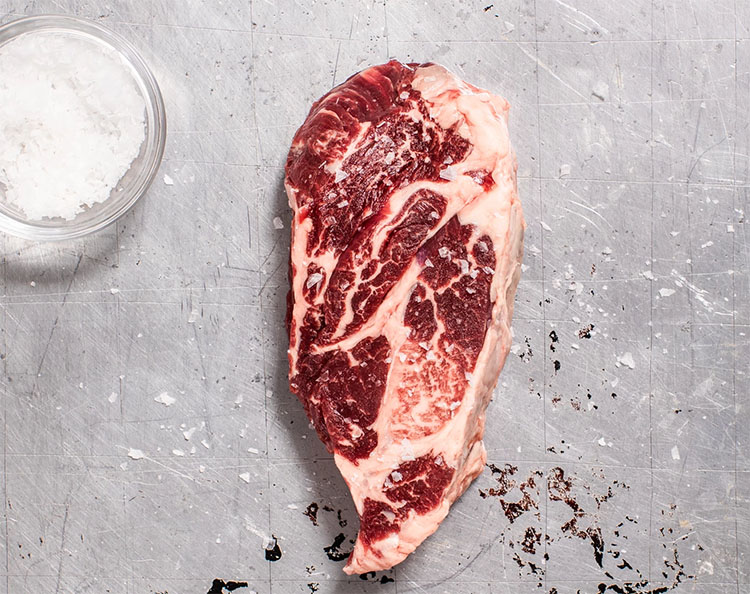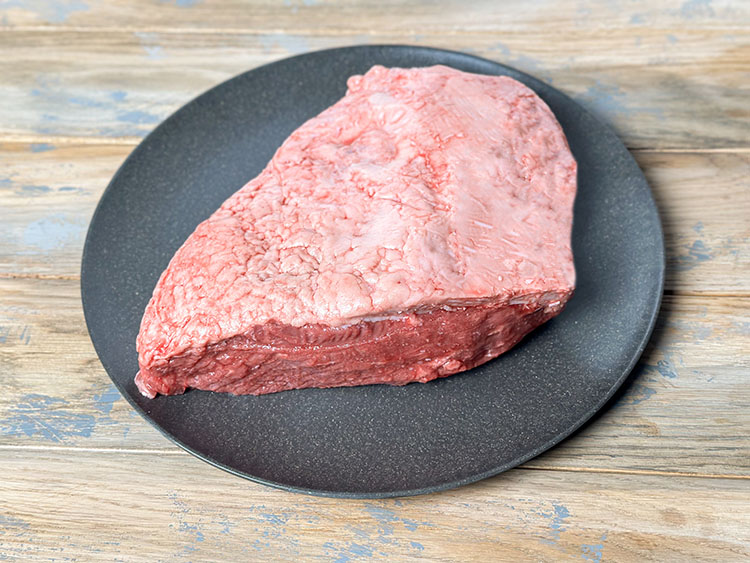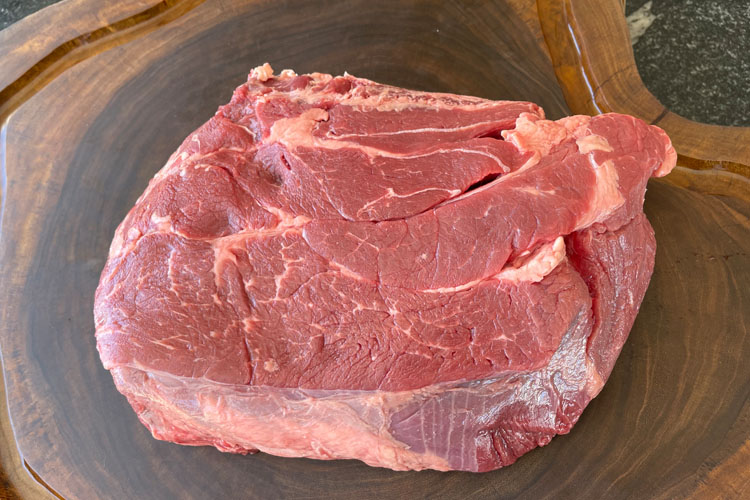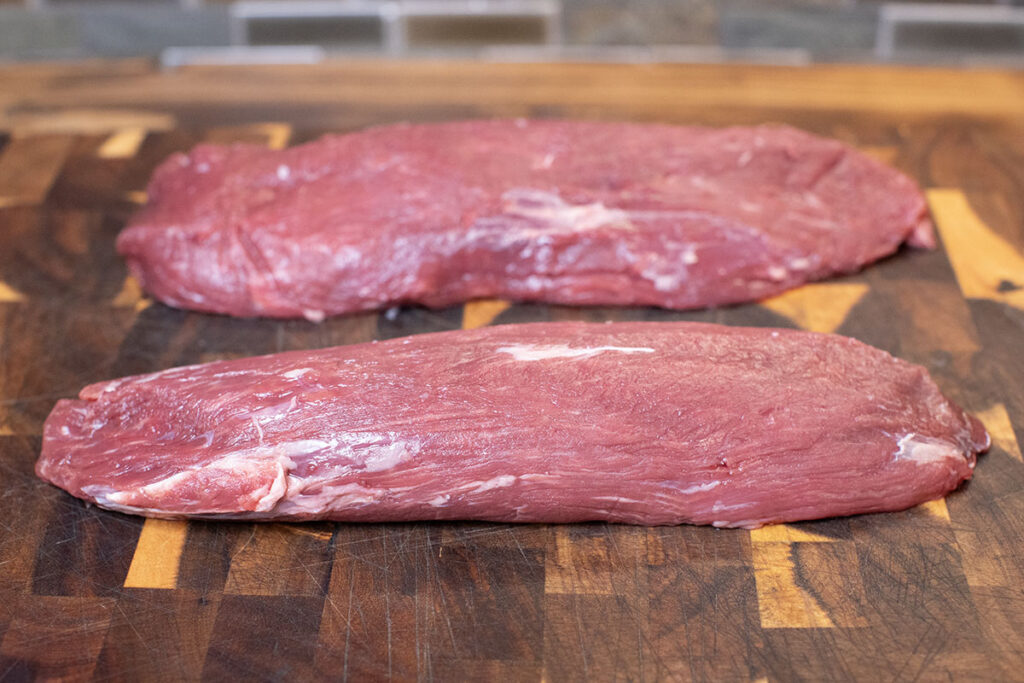To aid you in your fiscally responsible quest for steak, I’ve put together this guide to the best cheap steak cuts. These are the steaks I reach for when I’m trying to keep the grocery bill down.
To help you understand the value of these steaks, I’ve pulled data from the USDA National Retail Report so you can see how each of these cuts compares in price to ribeye steak.
The 9 best cheap steak cuts to grill
1. Chuck eye steak

Courtesy of Porterroad.com
Known as the “poor man’s ribeye,” the confusingly named chuck eye steak results from butchers slicing a standard ribeye into thinner sections, so there’s more to sell (sneaky!).
Like the ribeye, the chuck eye has a mild buttery flavor and a tender, juicy texture. It also has one of the highest fat ratios on this list of cheaper steak cuts. You’ll soon see most are lean and tough. The fat adds moisture and stops the meat from drying out—two key criteria.
According to the USDA’s latest National Beef Retail Report (from mid-April 2024), a boneless ribeye steak is $12.55 per pound, while chuck eye steak averages $9.44 per pound across several retailers. That means chuck eye steak is 25% cheaper.
So, chuck eye steak is ideal if you want a little slice of luxury without breaking the bank.
You can buy chuck eye steak from our friends at Porter Road.
Where does it come from?
The chuck eye is taken from the same longissimus dorsi muscle as the ribeye. Ribeyes are cut from a cow’s 6th to 12th rib, and the chuck eye is typically cut from the 5th and 13th rib in the same area where ground beef often originates.
There are only two of these steaks per carcass, meaning butchers themselves often snap them up. Hence the nickname “butcher’s steak.” But, if you can find one, you’ll get a lot of what makes ribeye special at a fraction of the price.
How do I cook it?
Like the ribeye, the chuck eye is best cooked hot and fast with a coarse salt and pepper seasoning. While it has a milder buttery smoothness compared to real ribeye, it’s still a tender piece of beef, so it benefits from a simple sear or reverse sear.
Leave the marinade and sauce for a different cheap steak cut, and keep things simple with the chuck eye to let the flavor shine through. Just remember to let it rest before serving.
2. Tri-tip steak

Trimmed whole tri tip
Tri-tip gets its name from its triangular shape. It’s also called California cut, triangle steak, breakfast steak, or Santa Maria steak. It first became popular in California before the masses heard about its goodness.
It doesn’t hurt that tri-tip steak is also 45% cheaper than boneless ribeye at $6.90 per pound.
The tri-tip combines tenderness with a fair amount of marbling. So ignore its less-than-pretty exterior and enjoy the flavor hidden underneath.
Where does it come from?
The tri-tip sirloin comes from the very bottom of the sirloin and the top of the round.
The round gets used a lot as the animal moves. So, the meat from this section is typically lean and can be a little tough, but it has a beautiful depth of flavor.
How do I cook it?
Lean as it is, tri-tip does not benefit from high heat or long cooking times. However, it adds a real flavor depth to fajitas, stir-fries, and bulgogi. A marinade helps break down some of that muscle protein before the meat is cooked as quickly as possible.
The reverse sear method also works great for this cut. For a detailed guide, check out our slow-smoked and reverse-seared tri-tip recipe. Then, transform leftovers into cheesy tri-tip steak sandwiches.
Cook it to medium and slice it against the grain for the optimal tri-tip steak experience. You’ll notice it slices up more like a brisket, and we’re certainly not complaining.
3. Flank & Skirt Steak

The wider flank steak on top and the thinner skirt steak below
The flank steak is often confused with the skirt steak, but these two cuts come from different parts of the cow.
Skirt steak is often fattier and typically tougher than flank steak. Both steaks pair leanness with a pronounced beef flavor and work well with marinades.
A little more on the expensive end, skirt steak is still 16% cheaper than boneless ribeye at $10.49 per pound, while flank is 15% cheaper at $10.68 per pound.
Where does it come from?
The skirt steak is a thin, fibrous piece that acts as the diaphragm muscle, while the flank steak comes from the cow’s abdomen.
Because these muscles are both highly used, the steak is lean and can be tough if not cooked correctly. They both come in relatively long strips of meat, but the flank is generally broader and flatter.
How do I cook it?
Both flank and skirt are best cooked hot and fast and then sliced against the grain. Don’t overcook, either. They can go from tender and juicy to tough in the blink of an eye.
Because they’re naturally lean with a thinner cut, both steaks benefit from a nice marinade and a quick pounding to add tenderness and loosen the texture before being grilled.
The longer you marinate them, the better, so don’t be afraid to leave them in the fridge overnight.
Popular dishes using these cuts include tacos, fajitas, and carne asada. You can also butterfly a flank steak and stuff it, like in our grilled steak pinwheels. If you have a really nice thick flank steak, you can even smoke it.
4. Flat iron

Seasoned flat iron steak
The flat iron has traditionally been a low-cost cut of beef because of the large vein of thick, chewy connective tissue that used to run across the cut.
In 2007, food scientists developed a new technique for carving away the connective tissue, similar to filleting a fish. This technique makes the flat iron a great alternative to the much more expensive New York Strip.
Despite its reinvention, the flat iron has remained very reasonably priced. It’s a surprisingly cheap cut with a tenderness that rivals a ribeye or filet mignon. In fact, it’s 20% cheaper than boneless ribeye at $10.04 per pound, and you can conveniently pick it up from Porter Road.
Where does it come from?
The flat iron comes from the steer’s shoulder and is sometimes called the top blade or shoulder top blade.
Despite coming from the primal chuck (a traditionally lean section), it’s incredibly well-marbled and tender. The marbled fat softens when cooked, preventing it from becoming too chewy. It also has a rich, beefy flavor.
How do I cook it?
One of the benefits of the flat iron is that it’s a very versatile piece of meat. The presence of all that marbling and tenderness means it’s well-suited to pan-frying or grilling. If you opt for grilling, add a simple salt and pepper seasoning.
It can also easily add a rich flavor boost to your Taco Tuesdays. Just add a spiced dry rub, and you’re good to go. Use it as a salad topper, or try our reverse-seared flat iron with mushroom sauce for something different.
We recommend serving flat iron steak medium rare. If you cook it past medium, it tends to dry out quickly.
5. Sirloin cap (picanha)

Raw sirloin cap AKA Picanha
Another underrated cheap steak cut is picanha, also known as sirloin cap, rump cap, or coulotte.
It’s the steak of choice in Brazilian steakhouses but is becoming more popular in the States thanks to its budget-friendly price, well-marbled texture, and taste.
They say it combines sirloin texture, filet mignon tenderness, and ribeye taste. How does that sound?
If that doesn’t win you over, maybe the price will. Sirloin cap steak is only $6.66 per pound, a.k.a. approximately 47% cheaper than boneless ribeye.
Where does it come from?
Sirloin is another primal cut, which means it gets more of a workout than the ribeye. It’s triangular in shape and sits on top of the cow’s rump.
The good news is it has a pretty thick fat cap, which protects it during grilling and adds a juicy beef flavor.
How do I cook it?
If you want to go the traditional route, picanha is served on skewers for Brazilian churrasco. Or you can go smaller and transform it into grilled beef kebabs.
Its fat cap also makes it an excellent option for smoking. Smoked picanha can be turned into individual steaks, sandwich meat, or a shaved meat salad topper.
6. Chuck steak

Chuck steak
The chuck steak (not to be confused with the chuck eye steak) is often called the “seven-bone steak” because—you guessed it—it includes a large bone shaped like a “7.”
The large bone’s presence and the fact it’s relatively unknown compared to the illustrious ribeye means you can pick up a chuck steak for a very reasonable price.
When it’s properly cooked, it has a wonderfully deep beefy flavor. So you’ll be rewarded if you’re not afraid of a little more chew than the ribeye and a little more effort.
Another way you’ll be rewarded is in price. Chuck steak is only $6.74 per pound, nearly half the price of boneless ribeye. Are you sold yet?
Where does it come from?
The chuck steak comes from the chuck primal section pressed right up against the rib. It has a reputation for being tough because a steer’s shoulder does a lot of work.
However, the chuck steak’s position in the transitional zone between the chuck and rib gives it a combination of the chuck’s rich flavor and the rib’s tender texture. Essentially, you get the ribeye taste without the price tag.
How do I cook it?
The large bone and attached connective tissue in the chuck steak make it a prime candidate for low and slow cooking. My personal favorite way to cook chuck steak is to cube it up and make poor man’s burnt ends.
7. Petite tender (teres major)

Long lean teres major (petite tender)
Do you know what’s cheaper than buying a tenderloin? Grabbing a petite tender instead.
The petite tender is basically the second generation of cheap steak cuts and another product of the prolific Beef Innovations Group. Also known as the teres major, it was created to be a more affordable alternative to the hanger steak, itself once considered a good value piece of beef.
As word spread about the hanger steak and prices increased, the petite tender became an affordable alternative to a formerly cheap one.
Either way, when properly cooked, this beef cut has a lean, tender, and spongy texture like a budget-friendly filet mignon. Combining solid muscle with some fat, it’s also packed with rich flavor. Need we say more?
Where does it come from?
The ever-versatile chuck yields another winner in the petit tender. This particular cut supports the larger shoulder muscles but doesn’t actually see much use, leaving it tender and as well-marbled as its close neighbor, the flat iron.
There are only two per cow, and they’re small oval-shaped cuts (about half to one pound each). This is just another similarity to filet mignon, as they’re roughly the same shape and size.
How do I cook it?
If you treat this as a cheat’s filet mignon, we recommend cutting it into medallions and searing it briefly on a high-heat grill until it’s cooked medium rare. We reverse-seared this grilled teres major and served it with a garlic herb compound butter.
You could also keep your petite tender whole and roast it to a medium-rare before finishing it with a quick sear.
8. Merlot steak

Courtesy of BeefItsWhatsForDinner.com
The merlot is an excellent example of a great cut of meat that people aren’t aware of because it never makes it to supermarket shelves.
Supermarkets are often wary of stocking unfamiliar cuts for fear that customers will avoid them. Initially created by the Beef Innovations Group, the merlot has much in common with flank steak in terms of size, thickness, and shape. But the bonus is it’s much more tender with a strong flavor.
If you’re wondering about the name, the Beef Innovations Group picked it because it was evocative, like Denver steak and the western griller. But some say it’s also thanks to its deep-red color.
Where does it come from?
The merlot is cut from the gastrocnemius muscle, which is a mouthful in itself. It’s found above the shank and below the bottom round. Technically, it’s a medial portion of the meat round’s heel muscle.
Hind leg cuts are generally lean, tough cuts because they’re heavily used. But somehow, merlot steak manages to remain pretty tender.
How do I cook it?
The merlot is very similar to the flank steak and has the added benefit of that tender texture.
Whereas the flank benefits from marinating to break down its toughness, the merlot can be seared hot and fast without turning into boot leather. Enjoy it on its own or in a stir fry or sheet pan dinner.
The gastrocnemius muscle has a pronounced grain. So, to keep your freshly cooked merlot steak as tender as possible, slice it across the grain. You also don’t want to overcook it, as the more it cooks, the more pronounced the iron flavor.
Don’t forget to pair it with a glass of merlot!
9. Denver steak

Image courtesy Porterroad.com
The Denver steak comes from the same premier beef scientists that gave us the merlot, as part of the work of the Beef Innovations Group.
Despite coming from the traditionally low-value chuck area of the steer, the Denver is tender, well-marbled, and packed with flavor.
If you want to get your hands on some Denver steak you can’t go wrong ordering from Porter Road.
Where does it come from?
The Denver steak is cut from the serratis ventralis muscles. Situated under the shoulder blade of the steer, this muscle supports the more active tissues of the shoulder but doesn’t actually see much use itself.
This lack of activity means that the revealingly unknown Denver steak is actually the fourth most tender cut of beef on the carcass.
How do I cook it?
Much like the chuck eye, the Denver needs to be cooked in a way that preserves its flavor and makes the most of a surprisingly well-marbled and tender cut of chuck.
The reverse sear is ideal for this, as the indirect heat helps to render all the fat down into tasty collagen, but, if you are feeling adventurous, a sous-vide bath is an excellent way to make your Denver truly melt in the mouth.
How to make cheap steak taste expensive
So there you have it! A whole selection of cut-price beef that’ll grace your palate with rich flavors and delicate textures (and still leave you able to afford dessert).
Looking for advice on how to cook the perfect steak? Check out our guides to grilling steak on a charcoal grill, steak doneness and how to reverse sear a steak.
If you need help finding these value cuts, check out our guide on the best websites to order steak online.
Did you miss our previous article...
https://manstuffnews.com/backyard-grilling/grilled-and-smothered-pork-chops
 Backyard GrillingWeekend WarriorsAdvice from DadBeard GroomingTV Shows for Guys4x4 Off-Road CarsMens FashionSports NewsAncient Archeology World NewsPrivacy PolicyTerms And Conditions
Backyard GrillingWeekend WarriorsAdvice from DadBeard GroomingTV Shows for Guys4x4 Off-Road CarsMens FashionSports NewsAncient Archeology World NewsPrivacy PolicyTerms And Conditions
